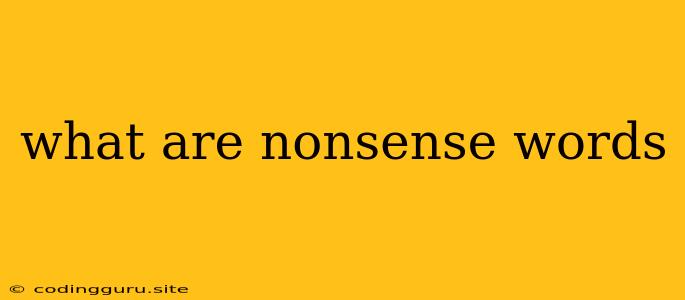What Are Nonsense Words?
Have you ever stumbled upon a word that sounds familiar, yet holds no real meaning? Or maybe you've encountered a string of letters that simply defy comprehension? These perplexing linguistic curiosities are known as nonsense words.
While seemingly nonsensical, these words can be surprisingly valuable in the world of language. They are not just random combinations of letters; they are deliberate creations, often with specific purposes.
Why Do Nonsense Words Exist?
Nonsense words play a significant role in various aspects of linguistics, psychology, and even entertainment:
- Linguistic Research: Researchers use nonsense words to understand how the human brain processes language. By testing how people pronounce and remember these invented words, they gain insights into the rules of phonology and morphology.
- Psychological Studies: Nonsense words are used to study memory, learning, and cognitive abilities. They serve as neutral stimuli, allowing researchers to isolate specific cognitive processes without the influence of pre-existing meanings.
- Children's Development: Nonsense words are a common tool for assessing a child's language development. Their ability to pronounce and understand these words provides valuable clues about their vocabulary acquisition and language processing skills.
- Creativity and Literature: Nonsense words have found their way into literature, poetry, and children's books, adding a playful element to storytelling. Think of words like "Jabberwocky" in Lewis Carroll's "Alice's Adventures in Wonderland," which adds a sense of whimsy and absurdity to the narrative.
Examples of Nonsense Words
Here are some examples of nonsense words that illustrate their diverse applications:
- Wug: This nonsense word is famous in linguistic research, often used to test children's understanding of pluralization.
- Gobbledygook: While not strictly a nonsense word, this term refers to unintelligible or nonsensical language, often used in bureaucratic or technical writing.
- Jabberwocky: This nonsense word from Lewis Carroll's "Alice's Adventures in Wonderland" exemplifies the use of nonsense words in literature for creative purposes.
- Snargle: This nonsense word is often used in psychological studies to assess memory and learning.
Creating Your Own Nonsense Words
If you're feeling adventurous, you can try creating your own nonsense words. Here are some tips:
- Start with a familiar sound: Choose a sound or syllable that is common in the language you're working with.
- Add a twist: Change the sound or syllable slightly, creating a new, unexpected word.
- Combine sounds: Experiment with combining different sounds and syllables to create unique nonsense words.
- Consider the context: Think about the purpose of your nonsense word and choose sounds that evoke the desired feeling or meaning.
Conclusion
Nonsense words may seem like mere linguistic oddities, but they serve important functions in various fields. From linguistic research to children's development, these words offer unique insights into language processing, memory, and creativity. Whether you're a language enthusiast, a researcher, or simply a curious individual, exploring the world of nonsense words is a fun and fascinating journey.
